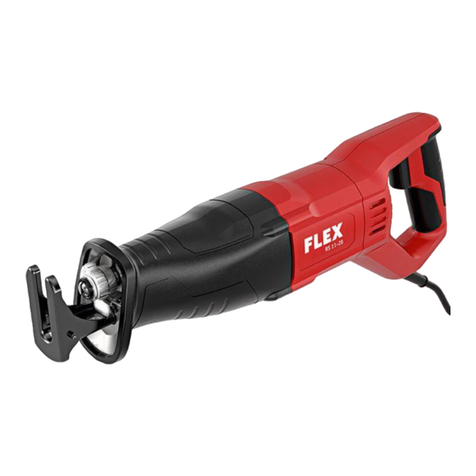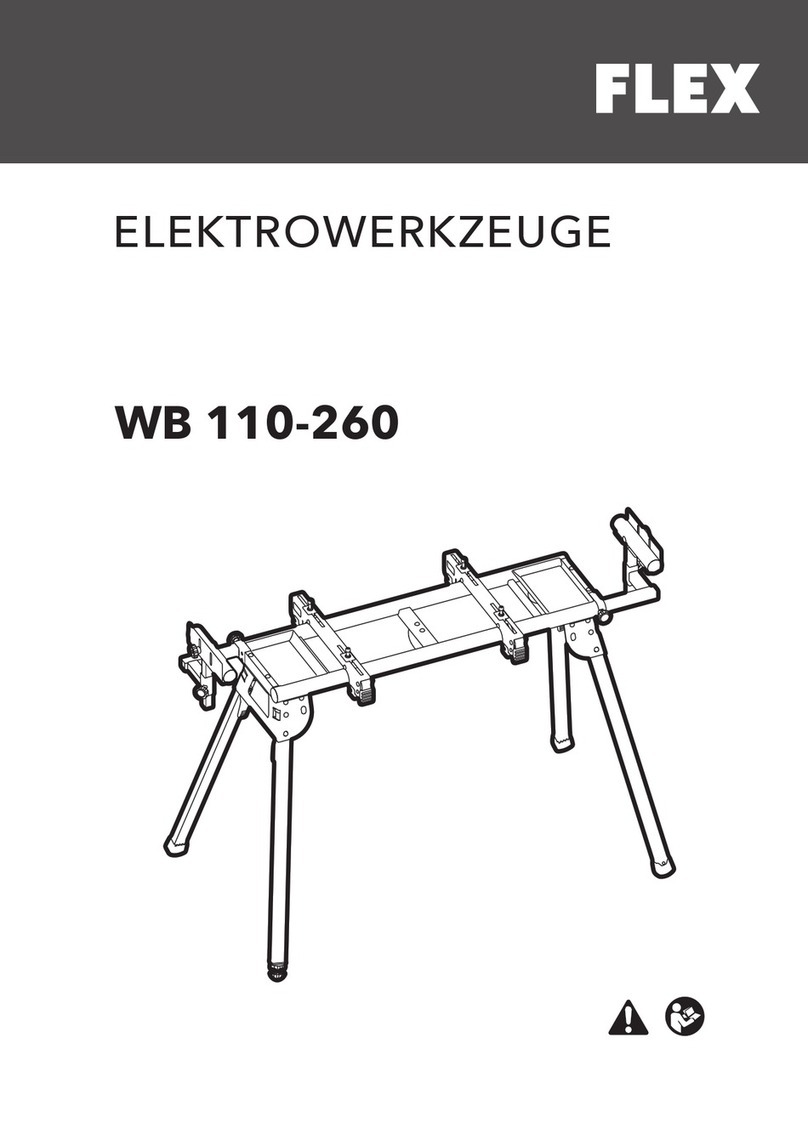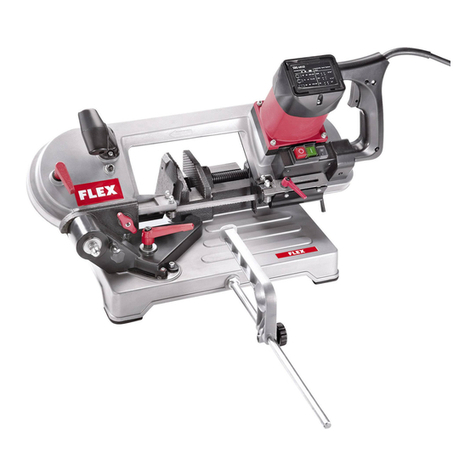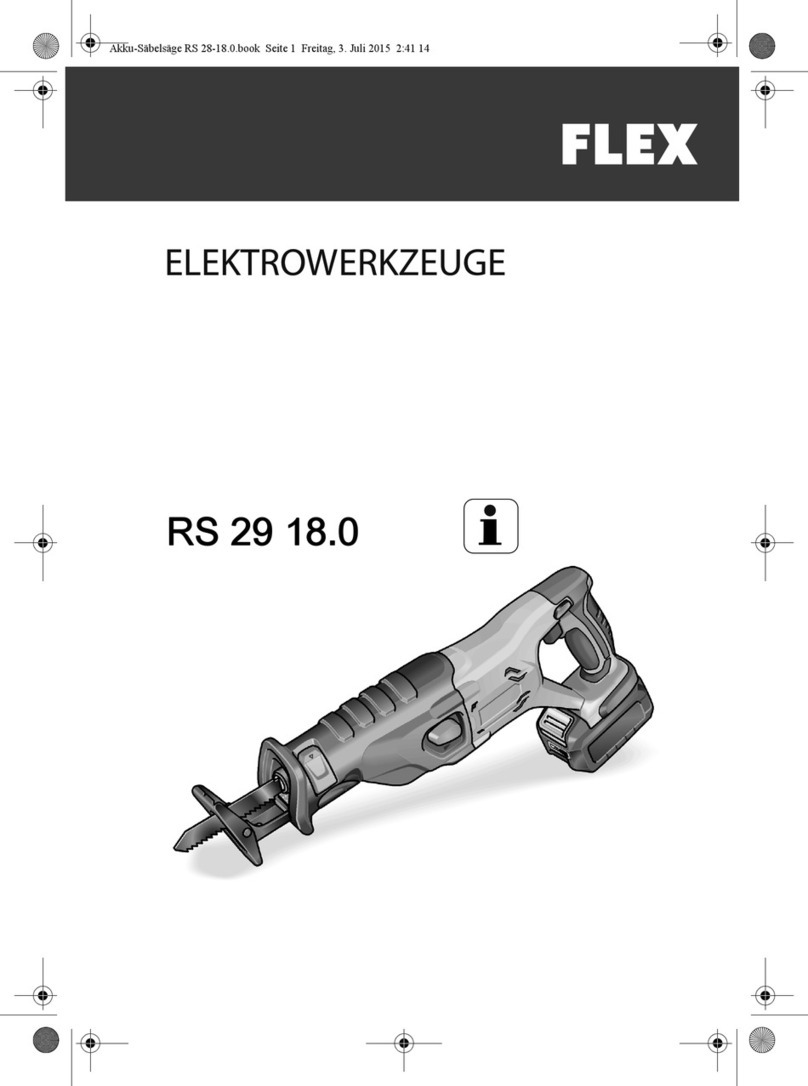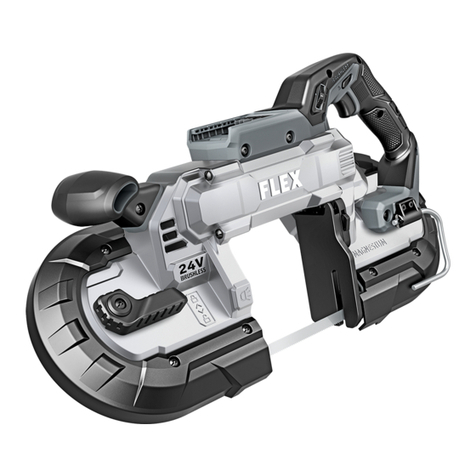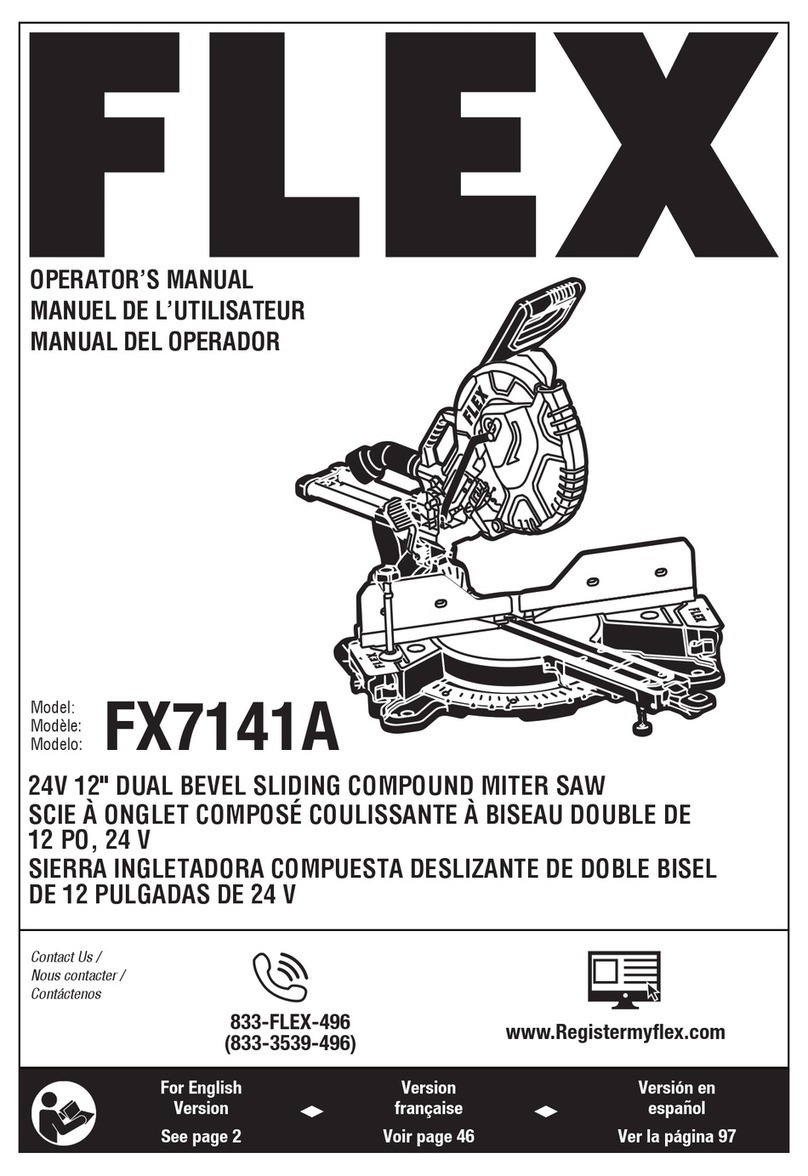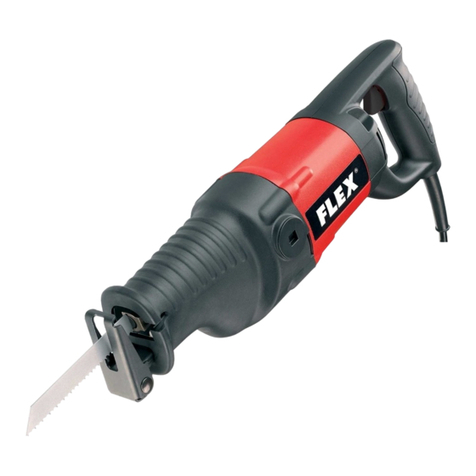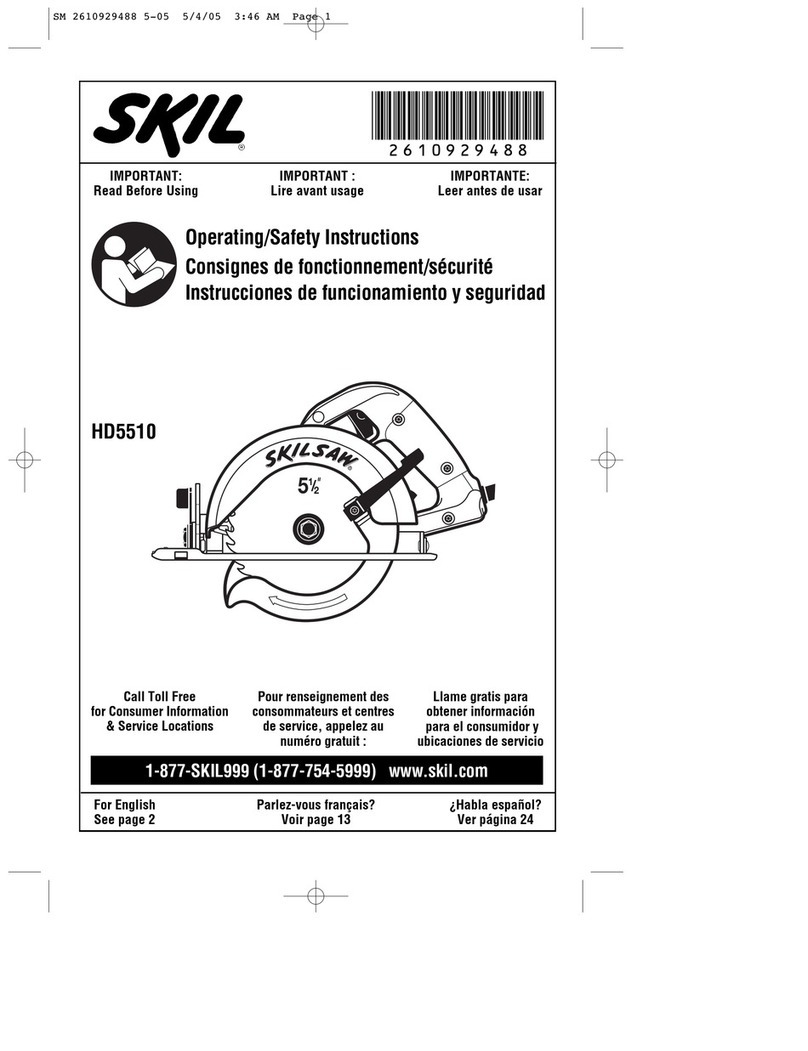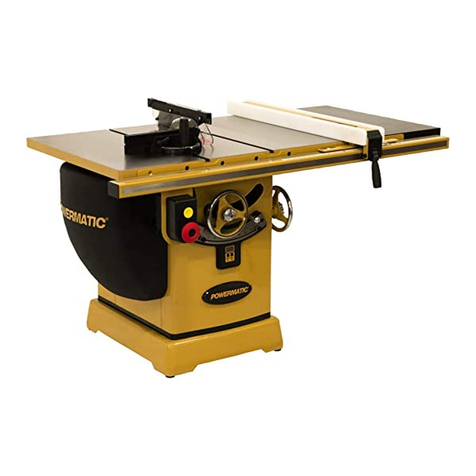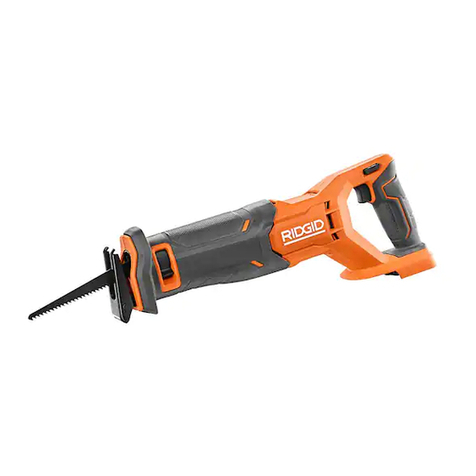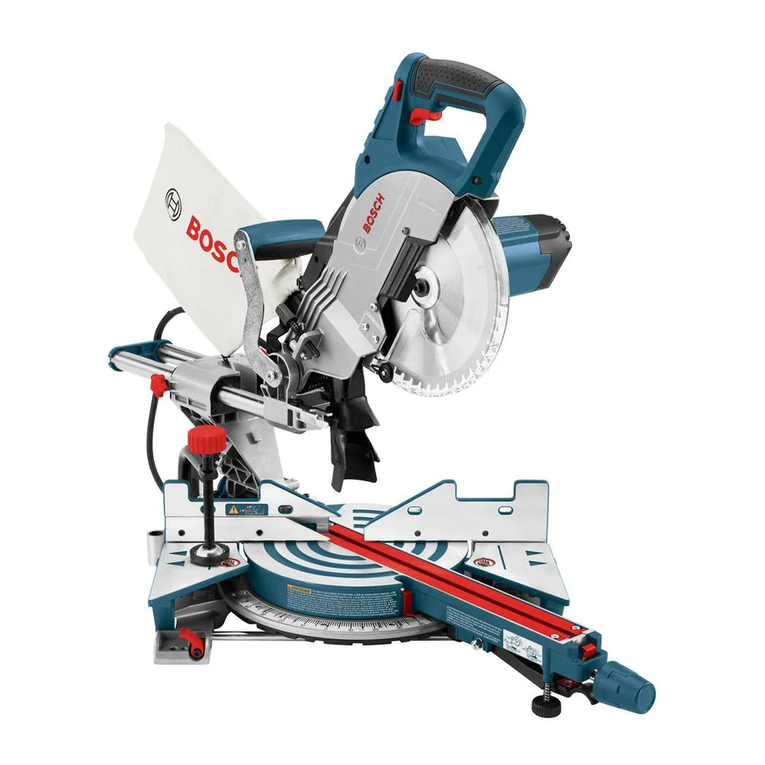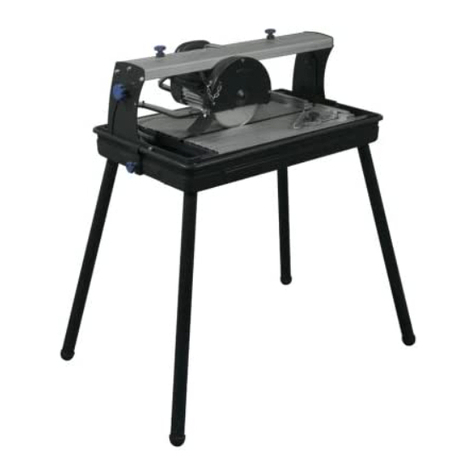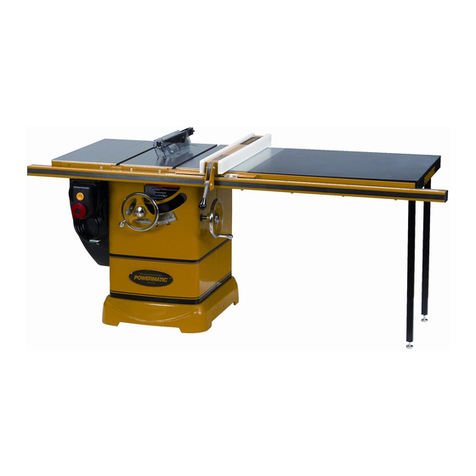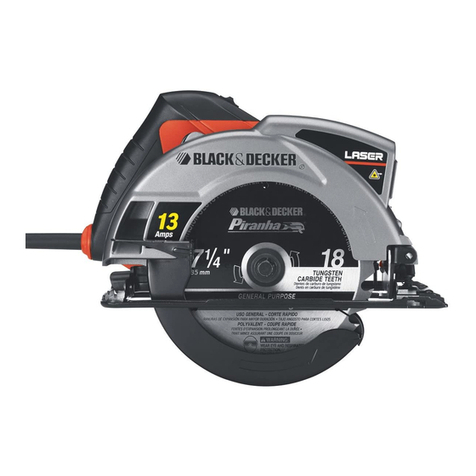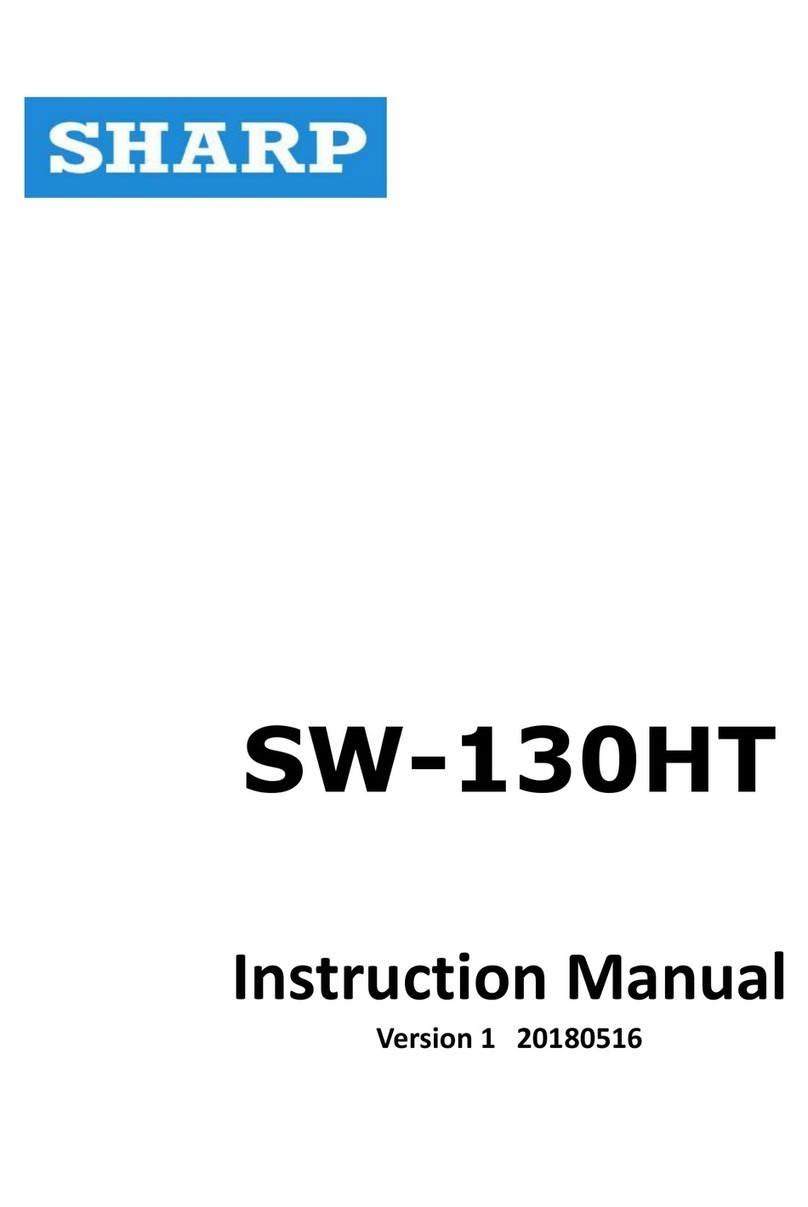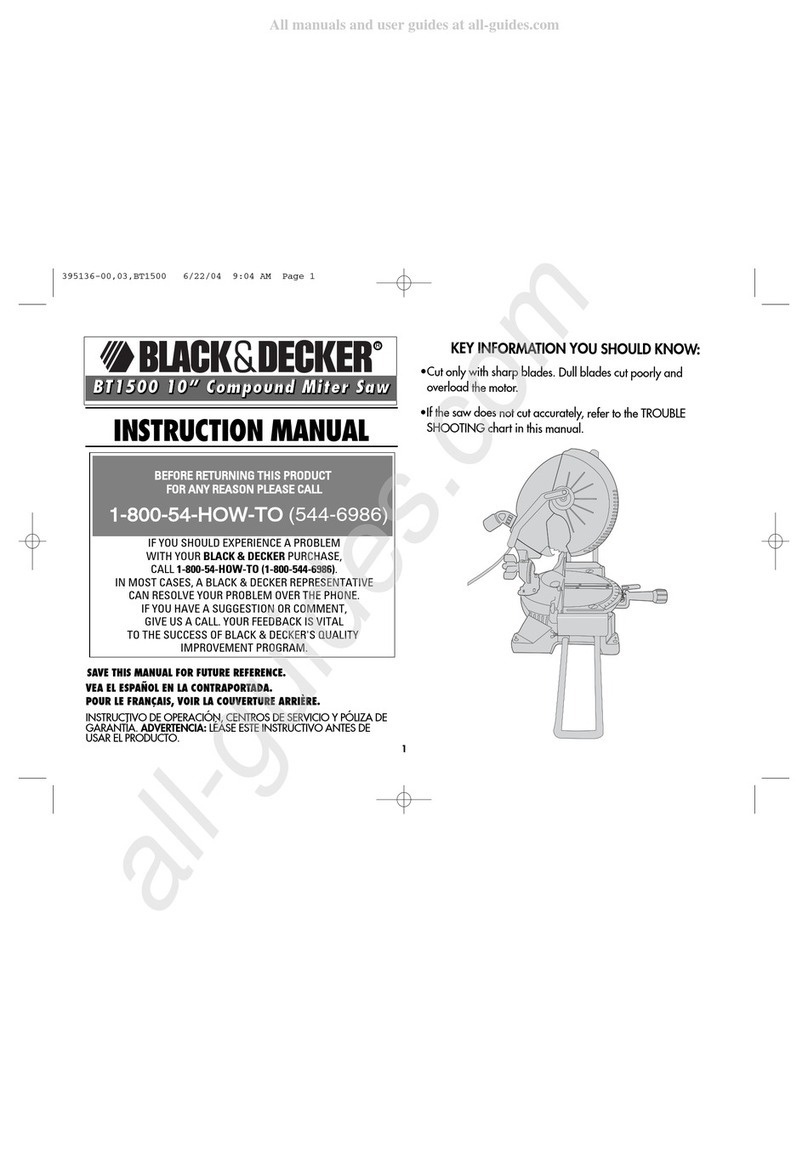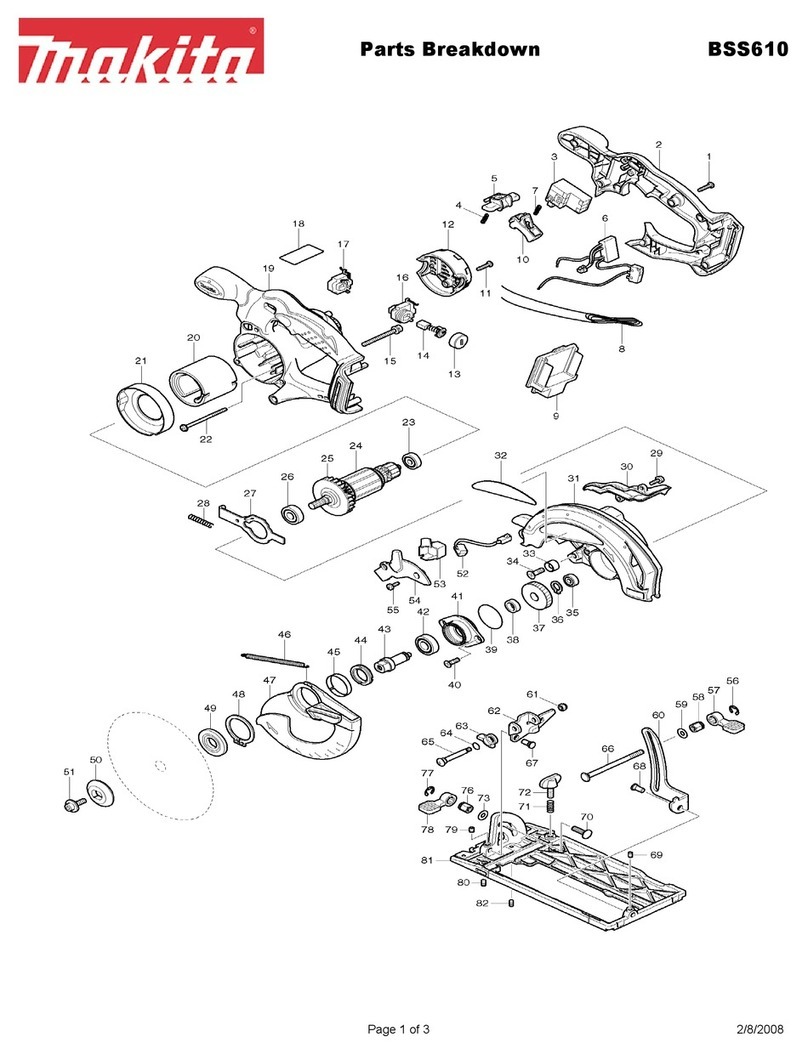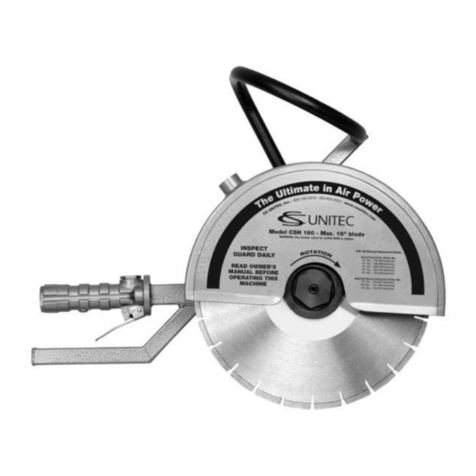Flex FX2141 User manual

Model:
Modelo:
Modèle:
OPERATOR’S MANUAL
MANUAL DEL OPERADOR
MANUEL DE L’UTILISATEUR
833-FLEX-496
(833-3539-496)
For English
Version
See page 2
◆
Version
française
Voir page 24
◆
Versión en
español
Ver la página 49
www.Registermyex.com
Contact Us /
Nous contacter /
Contáctenos
24V BRUSHLESS CIRCULAR SAW
SCIE CIRCULAIRE SANS BALAI DE 24 V
SIERRA CIRCULAR SIN ESCOBILLAS DE 24 V
FX2141

-2-
SAFETY SYMBOLS
The purpose of safety symbols is to attract your attention to possible dangers. The safety symbols
and the explanations with them deserve your careful attention and understanding. The symbol
warnings do not, by themselves, eliminate any danger. The instructions and warnings they give are
no substitutes for proper accident prevention measures.
WARNING Be sure to read and understand all safety instructions in this Owner's Manual,
including all safety alert symbols such as “DANGER,” “WARNING,” and
“CAUTION” before using this tool. Failure to follow all instructions listed below may result in electric
shock, re, and/or serious personal injury.
The denitions below describe the level of severity for each signal word. Please read the manual and
pay attention to these symbols.
This is the safety alert symbol. It is used to alert you to potential personal
injury hazards. Obey all safety messages that follow this symbol to avoid
possible injury or death.
DANGER DANGER indicates a hazardous situation which, if not avoided, will result in
death or serious injury.
WARNING WARNING indicates a hazardous situation which, if not avoided, could result
in death or serious injury.
CAUTION CAUTION, used with the safety alert symbol, indicates a hazardous situation
which, if not avoided, will result in minor or moderate injury.
Damage Prevention and Information Messages
These inform the user of important information and/or instructions that could lead to equipment or
other property damage if they are not followed. Each message is preceded by the word “NOTICE”,
as in the example below:
NOTICE: Equipment and/or property damage may result if these instructions are not followed.
WARNING The operation of any power tools can result in foreign
objects being thrown into your eyes, which can result in
severe eye damage. Before beginning power tool operation, always wear
safety goggles or safety glasses with side shields and a full face shield when
needed. We recommend a Wide Vision Safety Mask for use over eyeglasses
or standard safety glasses with side shields. Always use eye protection which
is marked to comply with ANSI Z87.1.

-3-
GENERAL POWER TOOL SAFETY WARNINGS
WARNING Read all safety warnings, instructions, illustrations and specications
provided with this power tool. Failure to follow all instructions listed below may
result in electric shock, re and/or serious injury.
SAVE ALL WARNINGS AND INSTRUCTIONS FOR FUTURE REFERENCE.
The term “power tool” in the warnings refers to your mains-operated (corded) power tool or battery-
operated (cordless) power tool.
Work area safety
Keep work area clean and well lit. Cluttered
or dark areas invite accidents.
Do not operate power tools in explosive
atmospheres, such as in the presence of
ammable liquids, gases or dust. Power
tools create sparks which may ignite the dust or
fumes.
Keep children and bystanders away while
operating a power tool. Distractions can cause
you to lose control.
Electrical safety
Power tool plugs must match the outlet.
Never modify the plug in any way. Do
not use any adapter plugs with earthed
(grounded) power tools. Unmodied plugs
and matching outlets will reduce risk of electric
shock.
Avoid body contact with earthed or
grounded surfaces, such as pipes, radiators,
ranges and refrigerators. There is an
increased risk of electric shock if your body is
earthed or grounded.
Do not expose power tools to rain or wet
conditions. Water entering a power tool will
increase the risk of electric shock.
Do not abuse the cord. Never use the cord
for carrying, pulling or unplugging the
power tool. Keep cord away from heat, oil,
sharp edges or moving parts. Damaged or
entangled cords increase the risk of electric
shock.
When operating a power tool outdoors, use
an extension cord suitable for outdoor use.
Use of a cord suitable for outdoor use reduces
the risk of electric shock.
If operating a power tool in a damp location
is unavoidable, use a ground fault circuit
interrupter (GFCI) protected supply. Use of a
GFCI reduces the risk of electric shock.
Personal safety
Stay alert, watch what you are doing and
use common sense when operating a power
tool. Do not use a power tool while you are
tired or under the inuence of drugs, alcohol
or medication. A moment of inattention while
operating power tools may result in serious
personal injury.
Use personal protective equipment. Always
wear eye protection. Protective equipment such
as a dust mask, non-skid safety shoes, hard
hat or hearing protection used for appropriate
conditions will reduce personal injuries.
Prevent unintentional starting. Ensure
the switch is in the off-position before
connecting to power source and/or battery
pack, picking up or carrying the tool.
Carrying power tools with your nger on the
switch or energizing power tools that have the
switch on invites accidents.
Remove any adjusting key or wrench before
turning the power tool on. A wrench or a key
left attached to a rotating part of the power tool
may result in personal injury.
Do not overreach. Keep proper footing
and balance at all times. This enables
better control of the power tool in unexpected
situations.
Dress properly. Do not wear loose clothing
or jewelry. Keep your hair and clothing away
from moving parts. Loose clothes, jewelry or
long hair can be caught in moving parts.
If devices are provided for the connection
of dust extraction and collection facilities,
ensure these are connected and properly
used. Use of dust collection can reduce dust-
related hazards.
Do not let familiarity gained from frequent
use of tools allow you to become
complacent and ignore tool safety
principles. A careless action can cause severe
injury within a fraction of a second.

-4-
Power tool use and care
Do not force the power tool. Use the correct
power tool for your application. The correct
power tool will do the job better and safer at the
rate for which it was designed.
Do not use the power tool if the switch
does not turn it on and off. Any power tool
that cannot be controlled with the switch is
dangerous and must be repaired.
Disconnect the plug from the power
source and/or remove the battery pack,
if detachable, from the power tool before
making any adjustments, changing
accessories, or storing power tools. Such
preventive safety measures reduce the risk of
starting the power tool accidentally.
Store idle power tools out of the reach of
children and do not allow persons unfamiliar
with the power tool or these instructions
to operate the power tool. Power tools are
dangerous in the hands of untrained users.
Maintain power tools and accessories.
Check for misalignment or binding of
moving parts, breakage of parts and any
other condition that may affect the power
tool’s operation. If damaged, have the power
tool repaired before use. Many accidents are
caused by poorly maintained power tools.
Keep cutting tools sharp and clean. Properly
maintained cutting tools with sharp cutting
edges are less likely to bind and are easier to
control.
Use the power tool, accessories and
tool bits etc. in accordance with these
instructions, taking into account the working
conditions and the work to be performed.
Use of the power tool for operations different
from those intended could result in a hazardous
situation.
Keep handles and grasping surfaces dry,
clean and free from oil and grease. Slippery
handles and grasping surfaces do not allow
for safe handling and control of the tool in
unexpected situations.
Battery tool use and care
Recharge only with the charger specied by
the manufacturer. A charger that is suitable for
one type of battery pack may create a risk of re
when used with another battery pack.
Use power tools only with specically
designated battery packs. Use of any other
battery packs may create a risk of injury and
re.
When battery pack is not in use, keep it
away from other metal objects, like paper
clips, coins, keys, nails, screws or other
small metal objects, that can make a
connection from one terminal to another.
Shorting the battery terminals together may
cause burns or a re.
Under abusive conditions, liquid may be
ejected from the battery; avoid contact.
If contact accidentally occurs, ush with
water. If liquid contacts eyes, additionally
seek medical help. Liquid ejected from the
battery may cause irritation or burns.
Do not use a battery pack or tool that is
damaged or modied. Damaged or modied
batteries may exhibit unpredictable behavior
resulting in re, explosion or risk of injury.
Do not expose a battery pack or tool to
re or excessive temperature. Exposure to
re or temperature above 265 °F may cause
explosion.
Follow all charging instructions and do
not charge the battery pack or tool outside
the temperature range specied in the
instructions. Charging improperly or at
temperatures outside the specied range may
damage the battery and increase the risk of re.
Service
Have your power tool serviced by a
qualied repair person using only identical
replacement parts. This will ensure that the
safety of the power tool is maintained.
Never service damaged battery packs.
Service of battery packs should only be
performed by the manufacturer or authorized
service providers.

-5-
SAFETY INSTRUCTIONS FOR CIRCULAR SAWS
Cutting procedures
DANGER Keep hands away from
cutting area and the blade.
Keep your second hand on auxiliary handle,
or motor housing. If both hands are holding
the saw, they cannot be cut by the blade.
Do not reach underneath the workpiece. The
guard cannot protect you from the blade below
the workpiece.
Adjust the cutting depth to the thickness
of the workpiece. Less than a full tooth of
the blade teeth should be visible below the
workpiece.
Never hold the workpiece in your hands or
across your leg while cutting. Secure the
workpiece to a stable platform. It is important
to support the work properly to minimize body
exposure, blade binding, or loss of control.
Hold the power tool by insulated gripping
surfaces, when performing an operation
where the cutting tool may contact hidden
wiring. Contact with a “live” wire will also make
exposed metal parts of the power tool “live” and
could give the operator an electric shock.
When ripping, always use a rip fence or
straight edge guide. This improves the
accuracy of cut and reduces the chance of
blade binding.
Always use blades with correct size and
shape (diamond versus round) of arbor
holes. Blades that do not match the mounting
hardware of the saw will run off-center, causing
loss of control.
Never use damaged or incorrect blade
washers or bolt. The blade washers and
bolt were specially designed for your saw, for
optimum performance and safety of operation.
Kickback causes and related warnings
Kickback is a sudden reaction to a pinched,
jammed or misaligned saw blade, causing
an uncontrolled saw to lift up and out of the
workpiece toward the operator;
When the blade is pinched or jammed tightly
by the kerf closing down, the blade stalls and
the motor reaction drives the unit rapidly back
toward the operator;
If the blade becomes twisted or misaligned in
the cut, the teeth at the back edge of the blade
can dig into the top surface of the wood causing
the blade to climb out of the kerf and jump back
toward the operator.
Kickback is the result of saw misuse and/or
incorrect operating procedures or conditions
and can be avoided by taking proper
precautions as given below.
Maintain a rm grip with both hands on
the saw and position your arms to resist
kickback forces. Position your body to
either side of the blade, but not in line with
the blade. Kickback could cause the saw to
jump backwards, but kickback forces can be
controlled by the operator, if proper precautions
are taken.
When blade is binding, or when interrupting
a cut for any reason, release the trigger and
hold the saw motionless in the material until
the blade comes to a complete stop. Never
attempt to remove the saw from the work or
pull the saw backward while the blade is in
motion or kickback may occur. Investigate
and take corrective actions to eliminate the
cause of blade binding.
When restarting a saw in the workpiece,
center the saw blade in the kerf so that the
saw teeth are not engaged into the material.
If a saw blade binds, it may walk up or kickback
from the workpiece as the saw is restarted.
Support large panels to minimize the risk of
blade pinching and kickback. Large panels
tend to sag under their own weight. Supports
must be placed under the panel on both sides,
near the line of cut and near the edge of the
panel.
Do not use dull or damaged blades.
Unsharpened or improperly set blades produce
narrow kerf causing excessive friction, blade
binding and kickback.
Blade depth and bevel adjusting locking
levers must be tight and secure before
making the cut. If blade adjustment shifts while
cutting, it may cause binding and kickback.
Use extra caution when sawing into existing
walls or other blind areas. The protruding
blade may cut objects that can cause kickback.

-6-
Lower guard function
Check the lower guard for proper closing
before each use. Do not operate the saw if
the lower guard does not move freely and
close instantly. Never clamp or tie the lower
guard into the open position. If the saw is
accidentally dropped, the lower guard may be
bent. Raise the lower guard with the retracting
handle and make sure it moves freely and does
not touch the blade or any other part, in all
angles and depths of cut.
Check the operation of the lower guard
spring. If the guard and the spring are not
operating properly, they must be serviced
before use. Lower guard may operate
sluggishly due to damaged parts, gummy
deposits, or a build-up of debris.
The lower guard may be retracted manually
only for special cuts such as “plunge cuts”
and “compound cuts”. Raise the lower guard
by the retracting handle and as soon as the
blade enters the material, the lower guard
must be released. For all other sawing, the
lower guard should operate automatically.
Always observe that the lower guard is
covering the blade before placing the saw
down on bench or oor. An unprotected,
coasting blade will cause the saw to walk
backwards, cutting whatever is in its path. Be
aware of the time it takes for the blade to stop
after switch is released.
Use clamps or other practical way to secure
and support the workpiece to a stable
platform. Holding the work by hand or against
your body is unstable and may lead to loss of
control.
Inspect the condition and quality of the wood
and remove all nails from lumber before
cutting. Wet lumber, green lumber or pressure
treated lumber require special attention during
cutting operation to prevent kickback.
Hold the saw rmly to prevent loss of
control. Figures in this manual illustrate typical
hand support of the saw.
This circular saw should not be mounted to
a table and converted to a table saw. Circular
saws are not designed or intended to be used
as table saws.
Never place your hand behind the saw
blade. Kickback could cause the saw to jump
backwards over your hand.
Do not use the saw with an excessive depth
of cut setting. Too much blade exposure
increases the likelihood of the blade twisting
in the kerf and increases the surface area of
the blade available for pinching that leads to
kickback
Do not run the tool while carrying it at your
side. Lower guard may be opened by a
contact with your clothing. Accidental contact
with the spinning saw blade could result in
serious personal injury.
Periodically remove the blade, clean the
upper, lower guards with kerosene and wipe
it dry, or blow it clean with compressed air.
Preventive maintenance and properly operating
guard will reduce the probability of an accident.
ADDITIONAL SAFETY WARNINGS
WARNING
• Some dust created by power sanding, sawing,
grinding, drilling and other construction
activities contains chemicals known to the
State of California to cause cancer, birth
defects or other reproductive harm. Some
examples of these chemicals are:
– Lead from lead-based paints.
– Crystalline silica from bricks, cement, and
other masonry products.
– Arsenic and chromium from chemically-treated
lumber.
• Your risk from these exposures varies,
depending upon how often you do this type
of work. To reduce your exposure to these
chemicals:
– Work in a well-ventilated area.
– Work with approved safety equipment, such as
dust masks that are specially designed to lter
out microscopic particles.
– Avoid prolonged contact with dust from power
sanding, sawing, grinding, drilling, and other
construction activities. Wear protective clothing
and wash exposed areas with soap and water.
Allowing dust to get into your mouth or eyes or
to lie on the skin may promote absorption of
harmful chemicals.

-7-
SYMBOLS
IMPORTANT: Some of the following symbols may be used on your tool. Please study them and
learn their meaning. Proper interpretation of these symbols will allow you to operate the tool better
and safer.
Symbol Name Designation/Explanation
V Volts Voltage
A Amperes Current
Hz Hertz Frequency (cycles per second)
W Watt Power
kg Kilograms Weight
min Minutes Time
s Seconds Time
Wh Watt-hours Battery capacity
Ah Ampere-hours Battery capacity
ø Diameter Size of drill bits, grinding wheels, etc.
n0No load speed Rotational speed, at no load
n Rated speed Maximum attainable speed
…/min Revolutions or reciprocations per
minute (rpm)
Revolutions, strokes, surface speed, orbits,
etc. per minute
O Off position Zero speed, zero torque...
1,2,3,…
Ⅰ,Ⅱ,Ⅲ, Selector settings Speed, torque, or position settings. Higher
number means greater speed
Innitely variable selector with off Speed is increasing from 0 setting
Arrow Action in the direction of arrow
Alternating current (AC) Type or a characteristic of current
Direct current (DC) Type or a characteristic of current
Alternating or direct current
(AC / DC) Type or a characteristic of current
Class II tool Designates Double Insulated Construction
tools.
Protective earth Grounding terminal
Li-ion RBRC seal Designates Li-ion battery recycling
program
Read the instructions Alerts user to read manual

-8-
Symbol Name Designation/Explanation
Wear eye protection symbol Alerts user to wear eye protection
Always operate with two hands Alerts user to always operate with two
hands
Do not use the guard for cut-off
operations Do not use the guard for cut-off operations

-9-
SYMBOLS (CERTIFICATION INFORMATION)
Symbol Designation/Explanation
This symbol designates that this tool is listed by Underwriters Laboratories.
This symbol designates that this component is recognized by Underwriters
Laboratories.
This symbol designates that this tool is listed by Underwriters Laboratories, to
United States and Canadian Standards.
This symbol designates that this tool is listed by the Canadian Standards
Association.
This symbol designates that this tool is listed by the Canadian Standards
Association, to United States and Canadian Standards.
This symbol designates that this tool is listed by the Intertek Testing Services,
to United States and Canadian Standards.

-10-
FUNCTIONAL DESCRIPTIONS AND SPECIFICATIONS
Circular Saw
Fig. 1a
Lock-off Button
Saw Hook
Upper Guard
Vacuum Hose
Adapter
LED Work Light
Blade Stud
Lower Guard
Lower-Guard Lift
Lever
Outer Blade-Washer
Calibrated Bevel
Quadrant
Trigger Switch
Auxiliary Handle
Bevel-Preset
Knob

-11-
Fig. 1b
Depth Bracket
Main Handle
Foot
Pivot Stud
Bevel-Adjustment
Lever
Bevel Indicator
Shaft-lock Button
Depth-Adjustment
Lever
Blade-Wrench
Storage Area
Depth-of-Cut
Marks
Model No. FX2141
Rated Voltage 24 V d.c.
No load Speed 5800 RPM
Bevel Capacity 0 – 56°
Blade 7-1/4" (184 mm)
Blade Arbor Hole 5/8" (16 mm)
Depth of cut at 90° 2-5/8" (66 mm)
Depth of cut at 45° 1-7/8" (48 mm)
Depth of cut at 56° 1-1/2" (38 mm)
Recommended operating temperature -4-104°F (-20-40℃)
Recommended storage temperature < 122℉ (< 50℃)

-12-
ASSEMBLY
WARNING Detach the battery pack
from the tool before
making any assembly, adjustments or
changing accessories. Such preventive safety
measures reduce the risk of starting the tool
accidentally.
TO ATTACH/DETACH BATTERY PACK (FIG. 2)
To attach the battery pack:
Align the raised rib on the battery pack with the
grooves in the tool, and then slide the battery
pack onto the tool.
NOTICE: Make sure that the latch on the
battery pack snaps into place and that the
battery pack is secured to the tool before
beginning operation.
NOTICE: When placing the battery pack
onto the tool, be sure that the raised rib
on the battery pack aligns with the groove
inside the tool and that the latches snap into
place properly. Improper attachment of the
battery pack can cause damage to internal
components.
To detach the battery pack:
Depress the battery-release button located
on the front of the battery pack, to release the
battery pack. Pull the battery pack out and
remove it from the tool.
WARNING Battery tools are always in
operating condition.
Therefore, remove the battery when the tool
is not in use or when carrying it at your side.
Fig. 2
Detach
Attach
Battery-release Button

-13-
ATTACHING THE BLADE (FIG. 3)
WARNING Detach the battery pack
from the tool before
performing any assembly or adjustments or
changing accessories. Such preventive safety
measures reduce the risk of starting the tool
accidentally.
WARNING Use only 7-1/4” saw
blades rated 5800/min
(RPM) or greater. NEVER use a blade that is
so thick that it prevents the outer blade
washer from engaging with the at side of
the spindle. Using a blade not designed for the
saw may result in serious personal injury and
property damage.
a. Take the blade wrench from its storage area.
b. Press the shaft-lock button and turn blade
wrench until the shaft-lock button engages.
The saw shaft is now locked. Continue to
depress the shaft-lock button, turn the blade
wrench counterclockwise and remove the
blade stud and the outer washer.
c. Make sure that the saw teeth and the arrow
on the blade point in the same direction as
the arrow on the lower guard.
d. Retract the lower guard all the way up into
the upper guard. While retracting the lower
guard, check the operation and condition of
the lower-guard spring.
e. Slide the blade through the slot in the foot
and mount it against the inner washer on the
shaft. Be sure that the large diameter of the
inner and outer washers lay ush against the
blade.
f. Reinstall the OUTER WASHER. First nger
tighten the blade stud, then tighten the blade
stud 1/8 turn (45˚) with the blade wrench
provided.
NOTICE: Do not use a blade wrench with
a longer handle, since it may lead to over
tightening of the blade stud.
NOTICE: Always clean the spindle, upper
guard, and lower guard to remove any dirt and
sawdust.
ATTACHING THE VACUUM HOSE ADAPTER
(FIG. 4)
WARNING Always wear a dust mask
during use.
Align the vacuum hose adapter with the opening
on the upper guard, x the vacuum hose
adapter in place by using a screw (provided).
To extract the saw dust created during cutting,
connect a suitable vacuum cleaner with a 1-1/4”
suction hose to the vacuum hose adapter.
Make sure the vacuum hose has freedom to
move and has enough length to complete the
cut. If needed, have another person move the
vacuum cleaner and the hose while you are
making the cut.
Before starting a cut, make sure that the airow
through the upper guard is not obstructed.
Fig. 3 Inner Washer
Blade
Blade Stud
Tighten
Loosen
Outer Washer
Shaft-Lock Button
Fig. 4
Opening
Vacuum Hose
Adapter
Ø1-1/4” (32mm)

-14-
ADJUSTMENTS
DEPTH ADJUSTMENT (FIG. 5A AND 5B)
Remove the battery pack from the circular saw.
a. Loosen the depth-adjustment lever by pushing
it up towards the motor housing.
b. Hold the foot down with one hand and use the
handle to raise or lower the saw.
c. Align the notch on the depth bracket with the
desired depth-of-cut mark on the upper guard
and tighten the depth-adjustment lever.
Check the set depth. Not more than one tooth
length of the blade should extend below the
material to be cut to minimize splintering.
NOTICE: The four most common cutting depths
are marked on the upper guard. These settings
help the operator to quickly set the saw to cut
through the material with thickness of 1/4", 1/2",
3/4", and 2×PLY, respectively, while allowing
one tooth length of the blade to extend below
the material.
CHECK THE 90° CUTTING ANGLE (FIG. 6)
Remove the battery pack from the circular saw.
a. Set the foot to the maximum depth of cut
setting. Loosen the bevel-adjustment lever,
set the bevel indicator to 0° on quadrant,
retighten the lever, and check for 90° angle
between the blade and bottom plane of foot
with a square.
b. Use a 2.5mm hex key (not included) to make
adjustments, if necessary, by turning the small
alignment screw from bottom side of the foot.
Fig. 5B
One tooth length should
penetrate wood for
minimum splintering
Fig. 5A
Notch on the
depth-bracket
Depth-of-Cut
Marks
Depth-
Adjustment
Lever
Fig. 6 Quadrant
Bevel
Adjustment
Lever
Bevel
Indicator
Foot
Alignment Screw
90o
Blade

-15-
BEVEL ADJUSTMENT (FIG. 7)
Remove the battery pack from the circular saw.
Your tool is equipped with a bevel-preset knob
and a bevel adjustment lever at the front of the
saw. to control bevel angle setting.
NOTICE: The bevel-preset knob of your saw
was set to 56° at the factory.
The bevel-preset knob allows the operator to
quickly set bevel at 22.5°, 45°, and 56°.
To use the bevel-preset knob
a. Push the bevel-preset knob and turn it to one
of the desired settings – 22.5°, 45°, or 56°.
b. Release the bevel-preset knob and it will
serve as a travel stop when adjusting the
bevel angle.
To use the bevel-adjustment lever
With the bevel-preset knob set, the operator can
quickly set the bevel angle to one of the presets
22.5°, 45°, and 56°or select a desired bevel
angle within the selected angle range.
a. Loosen the bevel-adjustment lever.
b. Tilt the saw as far as possible until it is
blocked by the bevel-preset knob at either
22.5°, 45°, or 56°. If a custom bevel angle
within the selected angle range
(e.g. 22.5 – 45°), tilt the saw until the bevel
indicator is aligned with the desired angle
mark on the quadrant.
c. Tighten the bevel-adjustment lever.
WARNING Because of the increased
amount of blade
engagement in the work and decreased
stability of the foot, blade binding may
occur. Keep the saw steady and the foot
rmly on the workpiece.
LINE GUIDE (FIG. 8)
For a 0° cut and a 45° bevel cut, use the
respective marks on the foot for guidance. The
cutting guide will indicate an approximate line
of cut. Make sample cuts in scrap lumber to
verify the actual line of cut. This will be helpful
because of the number of different blade types
and thicknesses available. To ensure minimum
splintering on the good side of the material to be
cut, face the good side down.
Fig. 7
Quadrant
Bevel-Preset Knob
Bevel
Adjustment
Lever
Fig. 8 0° Cuts
45° Bevel Cuts
Foot

-16-
SAW HOOK (FIG. 9)
Your tool is equipped with a hook. Use the hook
to hang the saw from a rafter or beam or other
similar secure structure for temporary storage
during work. Recommended lumber size to
support the saw with the hook: 2x4.
To use, lift up the hook until it snaps into the
open position.
When not in use, always lower the hook until it
snaps into the closed position.
WARNING When the saw is hung by
the hook, do not shake the
saw or the object that it is hanging from. Do
not hang the saw from any electrical wires.
Make sure that the structure used to hang
the saw is secure. Personal injury or property
damage may occur.
Only use the hook for hanging the saw.
Using the hook to hang anything else could lead
to serious injury.
Do not use the hook to reach another object
or use the hook to support your weight in
any situation.
Fig. 9 Saw Hook

-17-
OPERATION INSTRUCTIONS
WARNING To reduce the risk of re,
personal injury, and
product damage due to a short circuit, never
immerse your tool, battery pack or charger
in uid or allow a uid to ow inside them.
Corrosive or conductive uids, such as
seawater, certain industrial chemicals, and
bleach or bleach-containing products, etc. can
cause a short circuit.
WARNING If any parts are damaged
or missing, do not operate
this product until the parts are replaced. Use
of this product with damaged or missing parts
could result in serious personal injury.
WARNING Do not attempt to modify
this tool or create
accessories not recommended for use with
this tool. Any such alteration or modication is
misuse and could result in a hazardous
condition leading to possible serious injury.
WARNING To prevent accidental
starting that could cause
serious personal injury, always remove the
battery pack from the tool when assembling
parts.
This Circular saw must be used only with the
battery packs and chargers listed below:
Battery Pack Charger
2.5Ah 5Ah 8Ah 12Ah
FLEX FX0111 FLEX FX0121 FLEX FX0221 FLEX FX0231 FLEX FX0411 FLEX FX0421
NOTICE: Please refer to the battery pack and charger manuals for detailed operating
information.
SWITCH (FIG. 10)
To turn the tool “ON”, press and hold the
lock-off button with your thumb, then squeeze
the trigger switch with your nger. Release the
lock-off button and continue to squeeze the
trigger for continued operation.
To turn the tool “OFF”, release the trigger
switch, which is spring loaded and will return to
the off position automatically.
Your saw should be running at full speed
BEFORE starting the cut, and turned off only
AFTER completing the cut. To increase switch
life, do not turn switch on and off while cutting.
Fig. 10 Lock-Off Button
Trigger Switch

-18-
LED WORK LIGHT (FIG.11)
Your tool is equipped with the LED work light.
This provides additional light on the saw blade
and the surface of the workpiece for operation
in lower-light areas.
The LED work light will automatically turn on
with a slight squeeze of the trigger switch
before the tool starts running. It will turn off
approximately 10 seconds after the trigger
switch is released.
a. When the tool and/or battery pack becomes
overloaded or too hot, the internal sensors
will turn the tool off. If the tool and/or battery
pack are overloaded, the LED light will rapidly
ash. Rest the tool for a while or place the
tool and battery pack separately under air ow
for cooling.
b. The LED light will ash more slowly to indicate
that the battery pack charge is at low capacity.
Recharge the battery pack.
c. If the LED does not turn on when you start the
tool, or it turns off suddenly during operation,
please contact customer service or an
authorized service center for assistance.
GENERAL CUTS
Always hold the saw by the main handle with
one hand and the auxiliary handle with the
other. Maintain a rm grip with both hands
on the saw and position your arms to resist
kickback forces. Position your body to either
side of the blade, but not in line with the blade.
Make sure your body faces away from the
vacuum hose adapter.
WARNING Always be sure that
neither hand interferes
with the free movement of the lower guard.
Maintain a rm grip and operate the switch with
a decisive action. Never force the saw. Use light
and continuous pressure.
WARNING After completing a cut and
releasing the trigger, be
aware of the necessary time it takes for the
blade to come to a complete stop during
coast down. Do not allow the saw to brush
against your leg or side; since the lower
guard is retractable, it could catch on your
clothing and expose the blade. Be aware of
the necessary blade exposures that exist in
both the upper and lower guard areas.
To resume cutting when cutting is interrupted,
restart the saw, and allow the blade to reach
full speed, re-enter the cut slowly, and resume
cutting.
When cutting across the grain, the bers of the
wood tend to tear and lift. Advancing the saw
slowly minimizes this effect. For a nished cut, a
cross cut blade or miter blade is recommended.
NOT FOR CUTTING MASONRY/METAL
This tool is only designed for wood-cutting; it
is not designed for use with metal or masonry
cut-off wheels.
WARNING Do not use abrasive
wheels with circular saws.
Abrasive dust may cause the lower guard to not
operate properly.
Fig. 11
LED Work Light

-19-
PLUNGE CUTS (FIG. 12)
Remove the battery pack from the circular saw
before making adjustments.
a. Set the depth adjustment according to the
thickness of the material to be cut. Attach the
battery pack.
b. Hold the main handle of the saw with one
hand, tilt the saw forward, and rest the front of
the foot plate on the material to be cut. Line
up 0° mark on the foot with the line you’ve
drawn. Use the lower-guard lift lever to raise
the lower guard and hold the front of the foot
plate with the other hand (Fig. 12).
Position the saw so that the blade is just
clearing the material to be cut. Start the saw
and, once it is fully up to speed, gradually lower
the back end of saw using the front end of the
foot as the hinge point.
Once the foot plate rests at on the surface
being cut, release the lower guard and move
the hand holding the front of the foot plate to
hold the auxiliary handle. Proceed cutting in
forward direction to end of cut.
WARNING Allow blade to come to a
complete stop before
lifting the saw from the cut. Also, never pull
the saw backward, since blade will climb out
of the material and KICKBACK will occur.
Turn the saw around and nish the cut in the
normal manner, sawing forward. If corners of
your plunge cut are not completely cut through,
use a jig saw or hand saw to nish the corners.
CUTTING LARGE SHEETS (FIG. 13)
Large sheets and long boards can sag or bend,
depending on their support. If you attempt to
cut without leveling and properly supporting
the piece, the blade will tend to bind, causing
KICKBACK and extra load on the motor.
Support the panel or board close to the cut,
as shown in (Fig. 13). Be sure to set the depth
of the cut so that you cut through the sheet or
board only and not the table or work bench.
The two-by-fours used to raise and support
the work should be positioned so that the wide
sides support the work and rest on the table or
bench. Do not support the work with the narrow
sides, as this is an unsteady arrangement. If the
sheet or board to be cut is too large for a table
or work bench, use the supporting two-by-fours
on the oor and secure.
Fig. 13
Incorrect
Correct
Fig. 12
Lower Guard Lift
Lever
Foot Line Guide

-20-
RIP CUTS (FIG. 14)
The blade provided with your saw is designed
for both cross cuts and rip cuts. Ripping
is cutting lengthwise with the grain of the
wood. Rip cuts are easy to perform with a rip
fence (Fig. 14). A rip fence is available as an
accessory (Model FT211, not included). To
attach a fence, insert the fence through the slots
in the foot to the desired width, as shown, and
secure it with the locking nut (included with the
rip fence).
RIP-BOARD GUIDE (FIG. 15)
When rip cutting large sheets, the rip fence may
not allow the desired width of cut.
Clamp or nail a straight piece of 1” (25 mm)
lumber to the sheet as a guide (Fig. 15). Use
the right side of the foot against the board
guide.
WARNING Ensure that the clamps do
not interfere with the free
movement of the saw.
Fig. 14
Rip Fence
Desired Width
of Cut
Fig. 15
Desired Line of Cut
Rip Board Guide
This manual suits for next models
1
Table of contents
Languages:
Other Flex Saw manuals
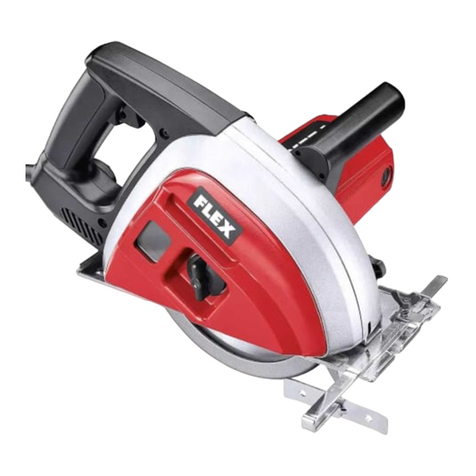
Flex
Flex CSM 4060 User manual
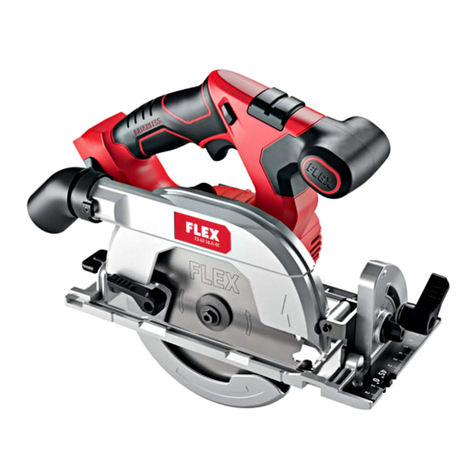
Flex
Flex CS 62 18.0-EC User manual
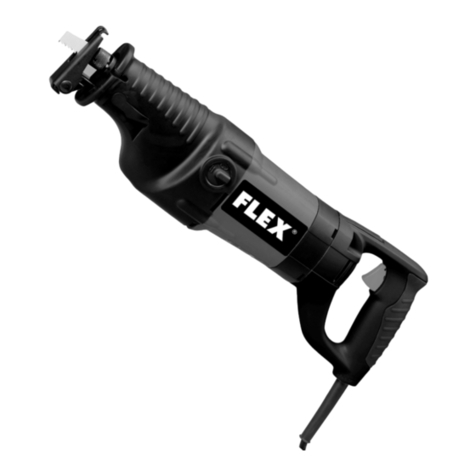
Flex
Flex SKE2902VV User manual
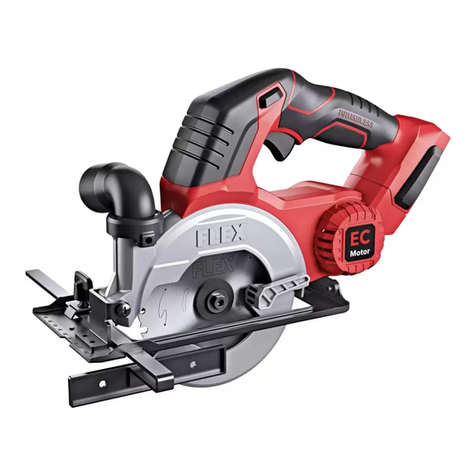
Flex
Flex CS 45 18.0-EC User manual
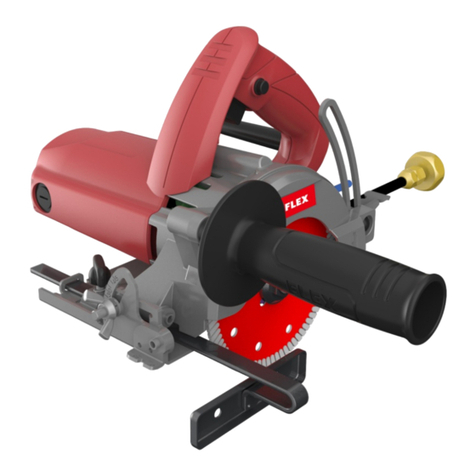
Flex
Flex CS 40 WET User manual

Flex
Flex CSE 55 T User manual
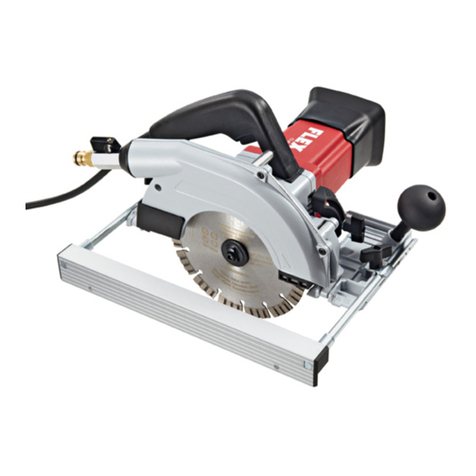
Flex
Flex CS 60 WET User manual
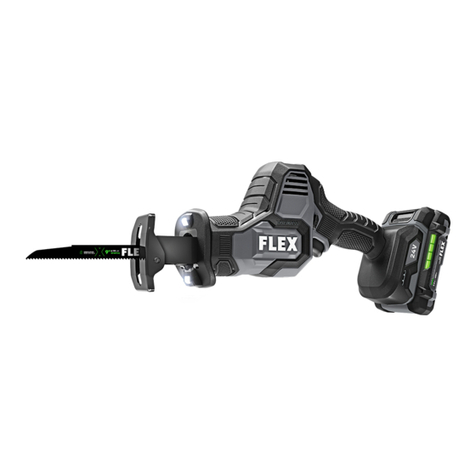
Flex
Flex FX2241 User manual

Flex
Flex CSM 4060 User manual
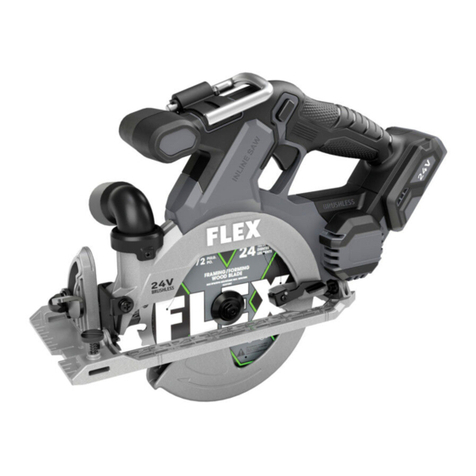
Flex
Flex FX2131A User manual
